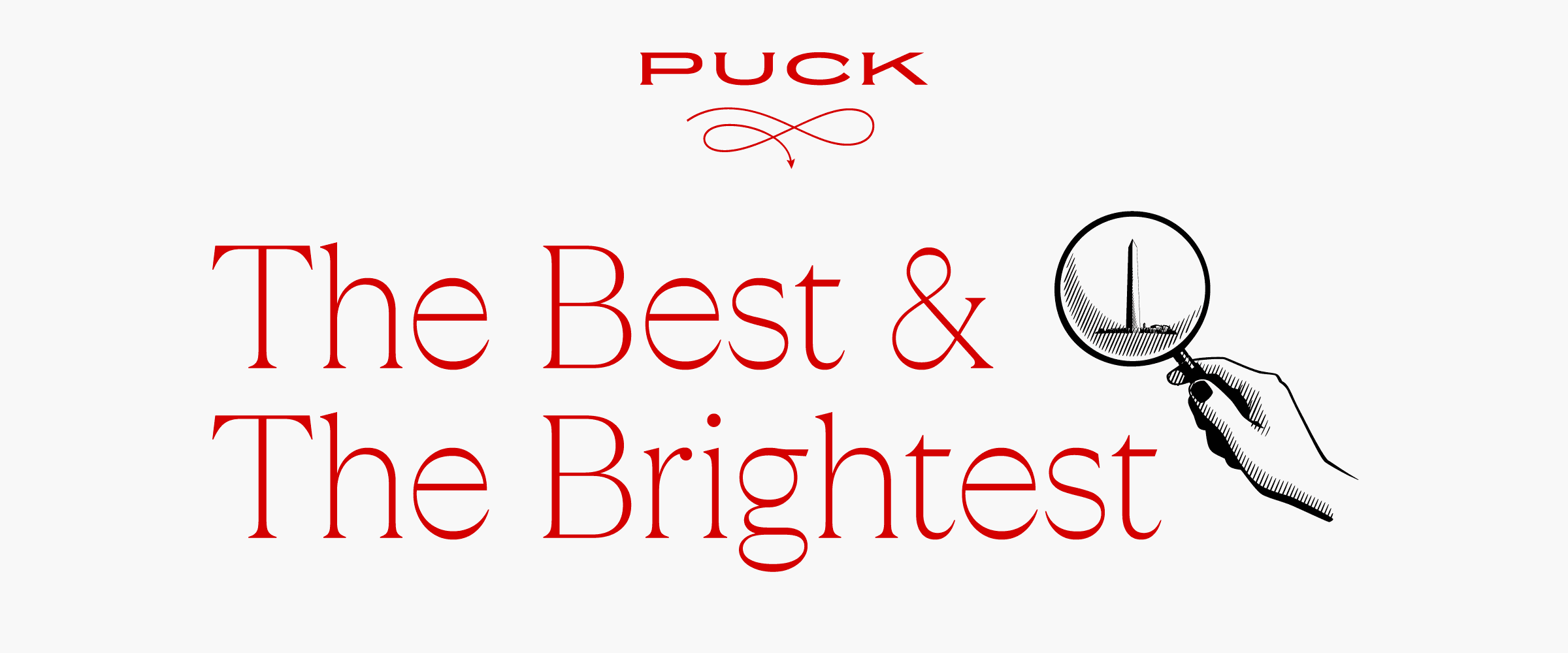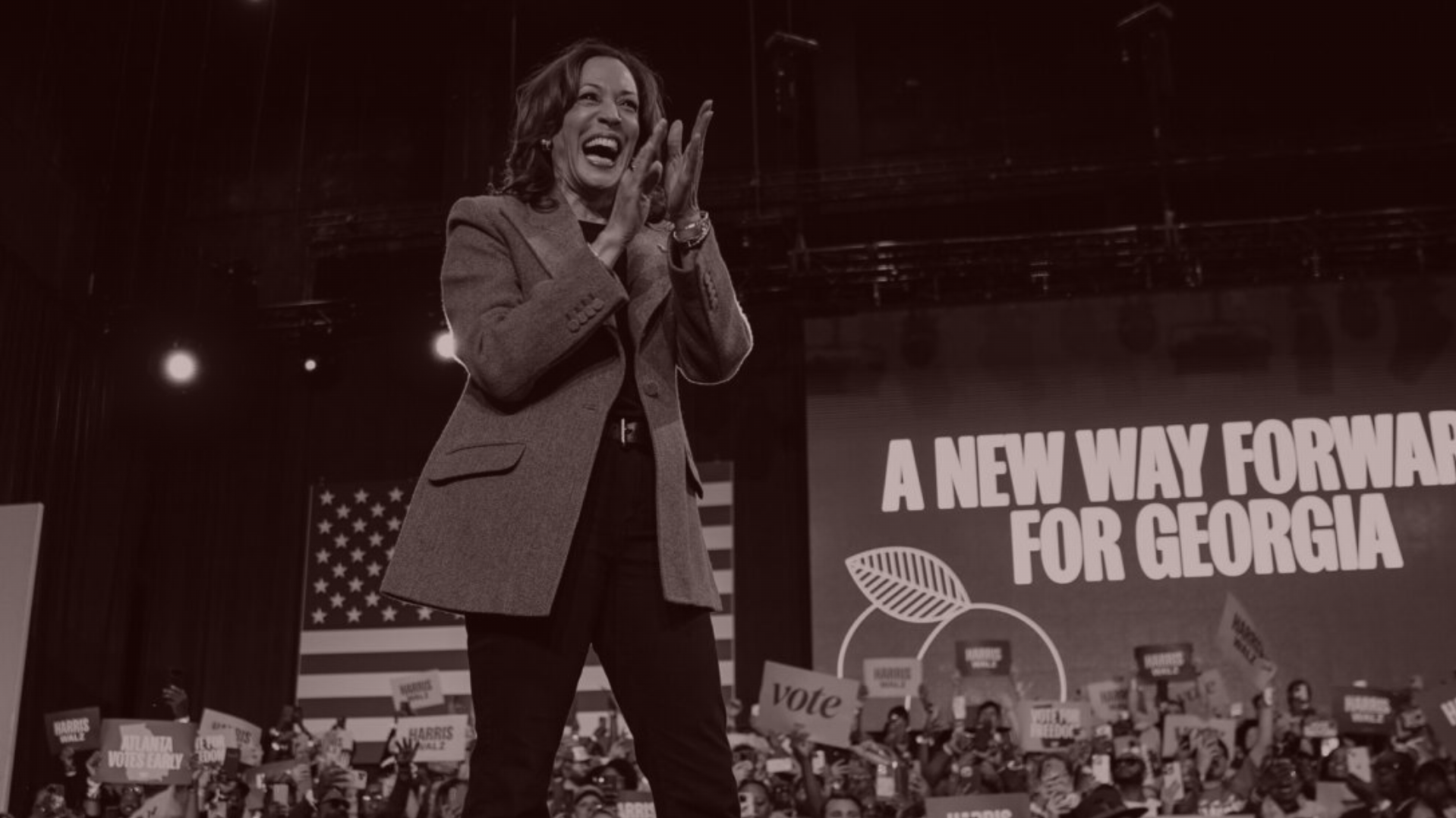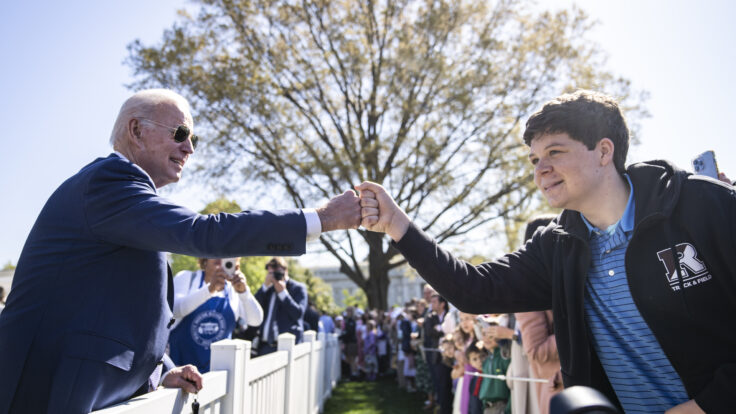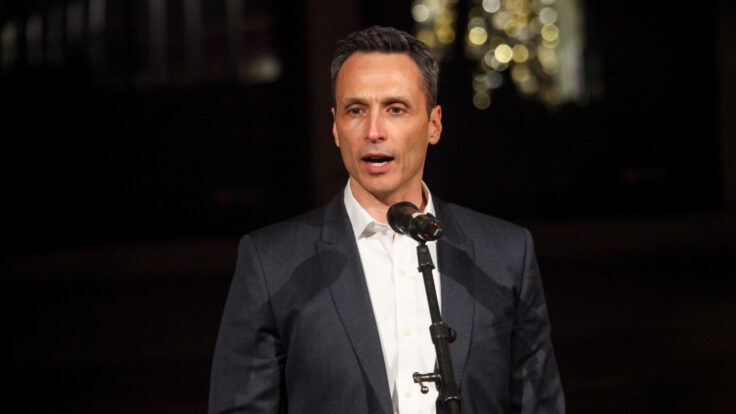 |
|
Welcome back to The Best & The Brightest, I’m Peter Hamby, writing to you live from Los Angeles where I just recorded another episode of The Powers That Be with Abby Livingston on the state of the race, which we’ll post later tonight. Meanwhile, make sure to tune in tomorrow to Amazon’s Election Night special with Brian Williams, featuring my colleagues Tara Palmeri and Baratunde Thurston live in the studio. I’ll be beaming in too with some live hits.
In tonight’s edition, while we all twiddle our thumbs until tomorrow evening, a close look at a few of the crucial, eleventh-hour questions that keep lighting up my text chains…
But first, here’s Abby Livingston with the latest in Washington…
|
| Washington in the Unbearable Calm Before the Storm |
|
Now that early voting is officially over, the political class is entering the slowest 24-hour period of the calendar: Election Day. Much like lawyers finding a way to stay occupied as a jury goes off to deliberate, political animals of all stripes—members, consultants, staffers, etcetera—will be searching for any and all means of distraction during that eerily calm window before results start rolling in. In the meantime, here’s the latest chatter…
- The oracle of Iowa: Pollster Ann Selzer jolted the political world on Saturday night with a poll showing Harris up three points in the state—a place that everyone thought was safely in the Trump column. Like all pollsters, Seltzer is fallible, but she is the most respected in the business. So, is Iowa actually in play? It’s hard to find anyone who thinks Iowa will flip, but the greater question is whether the poll’s broader findings—including that women are rapidly migrating to Harris—is a harbinger of how people will vote in other states. (Peter has more on this below.)
Within hours of the poll’s release, Iowa G.O.P. chair Jeff Kaufmann and Mitch McConnell advisor Josh Holmes poured some cold water on the poll. But even if Selzer is off by five or six points, a narrow Harris loss in Iowa—a state mostly ignored by both campaigns—would be stunning. One explanation, put forth by The Bulwark’s Tim Miller and others, is that Democratic TV ads for Nebraska’s competitive 2nd congressional district may have spilled across the state line; moreover, the abortion issue has drawn millions of ad dollars to House races in the Hawkeye state this cycle.
Despite G.O.P. efforts to cast doubt on Selzer’s credibility—and, to be fair, Democrats have done the same when her polls have leaned the other way—it’s clear that more than a few Republicans are shook. When I asked a G.O.P. operative on Monday if his peers were freaking out, he said, “Yeah, you could say that.”
- The Trump revenge scenario: Meanwhile, Democrats in the House are “nauseously optimistic” that Harris will win, to use the latest term of art. But even before Trump’s recent rhetorical escalation—imagining gun barrels trained on Liz Cheney, declaring that Nancy Pelosi should have been arrested for ripping up his S.O.T.U. speech in 2020—many Democratic members have been concerned about their personal and professional security in the event of a second Trump presidency.
Yes, there are immediate fears of Trump-stoked, January 6-style mayhem should Harris win, both immediately after Election Day and around a Harris inauguration on January 20. But members are particularly worried about Trump’s promise to deploy the power of the executive branch against his political enemies, and how that would undermine the day-to-day functioning of Congress. “Absolutely, people are afraid,” a senior House Democrat told me on Monday. Other Democratic members fear that the bedrock of checks and balances could crumble, especially if Trump weaponizes the Justice Department, or dissuades the F.B.I. from investigating crimes against members, or activates the intelligence community’s surveillance powers in ways that violate the sacred Speech or Debate Clause, which shields members from the disclosure of official correspondence, like emails.
Another Democratic member said that there will be a push to increase funding for the U.S. Capitol Police, to bolster officers’ ability to protect members—a bipartisan concern, with members on both sides rattled after two assassination attempts on Trump. “The rule of law is out the window, with enablers leading every agency and layers of enablers beneath them,” a senior Democratic member told me. “There are definitely members who are afraid and think we need more security.”
|
 |
| The Margin of Error Election |
| November 5 is upon us: At long last, we can stop texting each other polls showing yet another godforsaken tie, we can put to bed the spin and mumbo jumbo that grifters have been peddling about early-vote numbers, and we can mercifully stop talking about Tony Hinchcliffe. Here are my surprises, predictions, bellwethers, and other last-minute observations. |
|
|
|
| At some point this week—Wednesday? Thursday?—we’ll learn whether the United States has elected our first female president, Kamala Harris, or decided to run it back with Donald Trump. But the election will also answer a lot of questions about the country, its mood, and the electorate—questions that have dominated the ranks of political pundits and analysts for more than a year now.
Will the fight for abortion rights power Harris to a historic victory thanks to women? Can Trump offset her gains by running up the score with men? Will Gen Z actually show up? Will seniors continue to drift away from Trump’s G.O.P.? Will the war in Gaza hurt Harris with Arab and Muslim voters in Michigan? Can Trump actually make gains with Black and Latino men? Does the Democratic Party have any juice left with working-class whites? Do either of these candidates—one a sitting vice president, the other a former West Wing resident—actually represent change? I could go on and on.
While we all pass the time until tomorrow evening, with the fate of the world resting in the hands of a few thousands moms and dads in Bucks County, here are a few things worth keeping an eye on…
|
|
|
| While traveling through battleground states earlier this month, talking to younger voters, I was struck by how many undecideds I met out there in the real world. The idea that anyone could be undecided at this late juncture, with the choice so stark, just doesn’t compute with partisans and people who spend too much time online thinking about politics. But among those much-discussed “low-information” voters, undecideds are more common than you think. Many people in flyover country are cross-pressured to weigh prices and their pocketbooks against issues like abortion, immigration, or the fate of democracy.
This came up often in my conversations with middle- and working-class voters of color—even among people leaning in Harris’s direction—whom I met last month in North Carolina, Pennsylvania, Ohio, and Michigan. These undecideds make up only a small cohort of voters in the battleground states, but their indecision about the race—especially during the month of October, when Trump was bombarding voters with negative ads—is a big reason that Harris was unable to get over 48 percent in polls.
Over the weekend, Harris campaign manager Jen O’Malley Dillon offered a soothing message for news-addicted Democrats. “As we’ve looked at our data, those voters in the last week, in particular, are breaking for the vice president in double-digit margins,” she claimed in a campaign video that ignited a social media firestorm. If that’s true—and sure, it’s plausible—we’ll never know the exact reason. Was it Trump’s inability to deliver any kind of consistent message about the economy, his biggest advantage? His rambling rhetoric the last few weeks about violence, threats of revenge, and his promise to protect women “whether they like it or not?”
Or was it Harris hammering home a late message about the specter of fascism, a homily aimed squarely at fence-sitting suburbanites and Nikki Haley voters? Or was it the multiday news cycle about Tony Hinchcliffe and his racist joke at a MAGA rally about Puerto Rico being “a floating pile of garbage,” which seems like it saturated the news just as voters were starting to think about their votes?
None of this speculation means that Harris is assured of a win tomorrow (or Wednesday, or Thursday, or whenever). But if undecided voters are breaking for Harris at this late stage, it does appear that recent negative news cycles about Trump have been a factor. That’s according to a new poll from Echelon Insights, in partnership with Puck, which was surveying likely voters between October 28 and 31, just as the Puerto Rico story was going mega-viral. A plurality of voters—42 percent—said that information they had “seen, read, or heard recently” about Trump was making them feel “more negative” toward the former president. Only 33 percent of voters said the news about Trump made them feel “more positive.” Meanwhile, 43 percent of voters said the news environment made them feel “more positive” about Harris, and 39 percent said it made them feel “more negative” about her.
In short, if campaigns are about winning news cycles, Harris has been winning them at exactly the right time… or so the theory goes. Exit polls aren’t perfect, but they’ll report how many people made up their minds about the race in the last few days. We’ll find out soon enough if O’Malley Dillon was right about that “double-digit” margin among late deciders.
|
|
|
| Young voters have reliably leaned Democratic in presidential elections going back to the Obama years. No, they don’t vote at the same rates that older generations do, but they can be a difference-maker when they do show up. In the 2022 midterms, they made up only 12 percent of the electorate, but they broke for Democrats by an almost 40-point margin.
In the past few years, of course, a new dynamic has emerged: While young women are getting more progressive, Gen Z men (white men, in particular) are moving toward Trump—a trend that I have been covering all year. That rightward drift could hold Harris below 60 percent among young voters, generally considered the margin Democrats need to win with that demo. On the flip side, young women (especially young women of color) could blow the doors off for Harris—making up for any losses among the Trump bros who have received so much attention in the media.
Either way, every youth voter expert I know can’t wait for tomorrow because it’s just very hard to poll young voters these days and model how they’ll turn out. Polls of young voters have been all over the place this year, leading to some clashing narratives. The gold standard Harvard Youth Poll last month had Harris winning them by almost 30 points and hitting that crucial 60 percent hurdle. But the closely watched New York Times/Siena poll on Sunday had her winning young voters by just 17, and by even smaller margins in battleground states. A Mitchell Research poll of Michigan on Sunday showed Harris only winning young voters by six measly points. Who is right? We’ll find out tomorrow!
|
|
|
| Two of the big battlegrounds—Georgia and North Carolina—close their polls early-ish in the evening and start counting ballots (relatively) faster than other states on the map. Georgia closes at 7 p.m. ET and North Carolina at 7:30 p.m. ET. When the votes start to come in—refresh those BoE pages everyone!—a few bellwether counties will give us some early hints of where this election is headed.
In North Carolina, I’m keeping an eye on coastal New Hanover County, home to Wilmington. It’s not the biggest county in the state, but it’s been swingy up and down the ballot in recent cycles, thanks to the Port City’s mix of affluent property-owning whites, a growing population of younger couples moving there for pleasant coastal living, as well as more traditional blocs of Dem-voting Black residents and conservative Jessecrats who have kept Eastern North Carolina reliably Republican for generations. The county has a moderate vibe, with more unaffiliated voters here than registered Democrats or Republicans, and it went narrowly for Trump in 2016 before flipping back to Biden in 2020. If it looks like Harris is losing this county tomorrow night, Democrats should start drinking heavily.
Meanwhile, in Georgia, there are obviously a bunch of booming counties clustered around metro Atlanta that are worth watching to see if Harris is winning enough white suburbanites to keep her in the game. But I’ll have my eye on Fulton County, home to Atlanta. Harris will definitely win Fulton, but she needs mega-margins here with Black voters. Biden, Jon Ossoff, and Raphael Warnock all won more than 70 percent of the vote in Fulton in Georgia’s recent razor-thin elections. Harris needs to be above that number, and then some. If Trump is indeed making real gains with Black men, we might see the trend reflected in the vote count here. And if metro Atlanta isn’t popping off for Harris when the returns come in, it’s hard to imagine Philadelphia, Milwaukee, and Detroit will deliver good news for Democrats later in the evening.
|
|
|
| I am quite excited to no longer get texts from friends, relatives, donors —and pretty much everyone I know—asking me, Are the polls right this time? Literally, as I’m typing this, I got a text from a Democratic fundraiser here in Los Angeles: “OK, Peter, I need your prediction.” No, sir, you do not. I get it—people are anxious, we want to know if the pollsters have corrected for the polling errors in 2016 and 2020 that underestimated Trump’s strength, and we live in an impatient society in which data and technology are supposed to give us easy answers for everything. Well, not this year! Polls have basically shown a Harris-Trump tie in the battleground states for most of the fall.
We’ll see how the current polling averages shake out against the actual results. But insiders are very interested to see how two specific polls perform when the votes are in: Ann Selzer’s Iowa poll that dropped on Sunday showing Harris with a jaw-dropping three-point lead in the Republican state, and the New York Times/Siena poll, run by Nate Cohn, which has demonstrated a slight Trump lean all cycle even as other polls showed Harris winning.
The Selzer poll is absolutely fascinating. She’s demonstrated over many cycles now that she’s pretty close to accurate, and doesn’t care what other polls say. As Nate Silver wrote over the weekend, “In a world where most pollsters have a lot of egg on their faces, she has near-oracular status.” Look, Harris might not win Iowa. If she does, she’s winning this race by a historic landslide. But the Selzer poll showed Harris making incredible gains among white voters and seniors in a state that’s, well, very white and senior. If Harris really is running up the score with white women in Iowa, she’s probably doing the same in nearby Wisconsin and in Nebraska’s 2nd congressional district.
Meanwhile, the Times/Siena poll is considered as high-quality as it gets, with large sample sizes and weighting choices that have made it pretty damn accurate in past cycles. But this year, Cohn and his team have demonstrated a knack for raining on good Democratic vibes, consistently dropping polls in the middle of positive new cycles for Harris, often contradicting their previous polls, throwing Democrats into abject panic. They’ve often swung from one result to another, showing Harris up five in Arizona one month, and then down five another. Same in other states. Was the electorate seesawing back and forth, or was something up with the poll itself? Who knows! As Cohn himself would tell you, polling these days is harder than ever, much of it is guesswork, and the best polls are supposed to be reality checks, not warm blankets for whiny partisans.
Alas, so much of the polling industrial complex these days is geared toward indulging the fantasies of donors, building media narratives for candidates, or providing emotional support for voters who can’t bear to wait until Election Day. Crooked Media’s Dan Pfeiffer basically had a full-time job in 2024 with his Message Box newsletter, telling Democrats not to light themselves on fire every time the Times and Siena released a new poll showing Harris underperforming with Black voters and/or voters under 30. (The Times/Siena poll has also consistently shown Harris with durable strength among white voters, as compared to Biden’s winning margins in 2020.) Cohn’s final set of polls, released Sunday, show Harris and Trump both within the margin of error in most of the battlegrounds. Harris has a surprising late lead in North Carolina, which has leaned Trump for most of the year, and a three-point lead in Nevada. Trump has a more substantial four-point lead in Arizona. That will be a good test of whether the most watched poll in the country has been right all along—whenever Maricopa County actually finishes counting all its votes.
|
|
|
|
| FOUR STORIES WE’RE TALKING ABOUT |
 |
|
 |
|
 |
| Comcast’s Stunner |
| Assessing the viability of Comcast’s spinco concept. |
| WILLIAM D. COHAN |
|
 |
|
|
|

|
 |
|
|
|
Need help? Review our FAQs
page or contact
us for assistance. For brand partnerships, email ads@puck.news.
|
|
You received this email because you signed up to receive emails from Puck, or as part of your Puck account associated with . To stop receiving this newsletter and/or manage all your email preferences, click here.
|
|
Puck is published by Heat Media LLC. 227 W 17th St New York, NY 10011.
|
|
|
|

















